The Economics and Statistics Division maintains archives of previous publications for accountability purposes, but makes no updates to keep these documents current with the latest data revisions from Statistics Canada. As a result, information in older documents may not be accurate. Please exercise caution when referring to older documents. For the latest information and historical data, please contact the individual listed to the right.
<--- Return to Archive
For additional information relating to this article, please contact:
December 15, 2020JOB VACANCIES AND WAGES, Q1 2020 Statistics Canada has released its quarterly job vacancy and wage survey (unadjusted for seasonality) for the first quarter of 2020. This release provides data on the portion of jobs in a particular region, sector or occupation that are vacant. It also provides information on the wages offered on vacant positions as well as education and experience requirements. A higher job vacancy rate indicates a tighter labour market where it is more difficult for employers to find suitable candidates for the positions offered. A lower job vacancy rate signals labour market slack and potentially more job seekers competing for each vacant position.
Nova Scotia's job vacancy rate was 2.5% in the first quarter of 2020, representing 10,165 job vacancies (these data are unadjusted for seasonality and typically report more labour market slack in the winter months).
Nova Scotia's job vacancy rate is slightly higher than the 2.4% vacancy rate (9,425 vacancies) observed at the same time in 2019. The national job vacancy rate was 3.1%, unchanged from the first quarter of 2019.

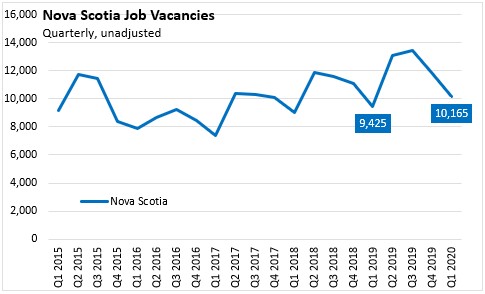
Across Canada, Q1 2020 job vacancy rates were highest in British Columbia, Quebec, New Brunswick and Ontario. The lowest job vacancy rates were reported in Alberta, Saskatchewan, Nova Scotia and Newfoundland and Labrador. Compared to Q1 2019, vacancy rates increased in Newfoundland and Labrador, Nova Scotia, New Brunswick, Quebec, Manitoba and Saskatchewan. Vacancy rates declined in British Columbia, Alberta, and Ontario.
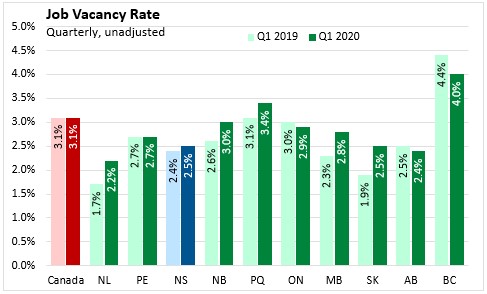
The average wage offered for a vacant position in Q1 2020 was $18.95 per hour in Nova Scotia, down from $19.65 in Q1 2019. The national average wage offered increased $0.80 per hour over Q1 2019 to $22.60.

Compared with Q1 2019, the average wage offered increased 3.7% nationally. Average wages on vacant positions were highest in Alberta, Ontario and British Columbia, and lowest in the Maritime provinces. Average wages offered on vacant positions increased in Prince Edward Island, New Brunswick, Quebec, Ontario, Alberta and British Columbia.
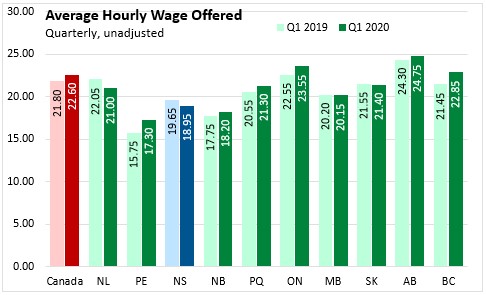
Among Nova Scotia's economic regions, Q1 2020 job vacancy rates were highest in Halifax, North Shore and Annapolis Valley. The lowest job vacancy rates were in Cape Breton and the Southern region, which showed more labour market slack compared to Q1 2019.
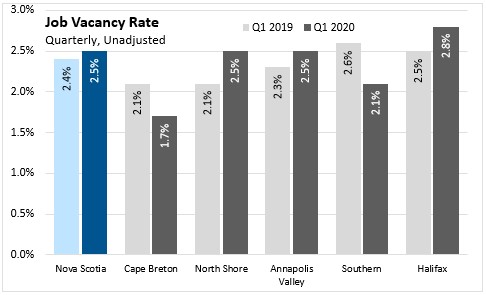
Compared with Q1 2019, average wages on vacant positions decreased in all regions except North Shore (+0.60/hour).
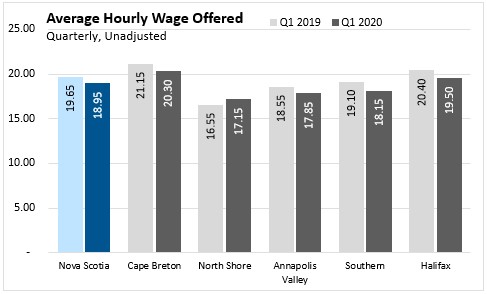
Across sectors with available data, Nova Scotia's Q1 2020 job vacancy rates were lower than the national average in every category except manufacturing, information and cultural, administrative/waste management, and accommodation/food services. Suppressed data are labelled as 'n/a'.

Compared to the national average, the wages offered for vacant positions in Nova Scotia were lower for all sectors in Q1 2020 except retail trade. For sectors with available data, the largest wage differences were found in wholesale trade, administrative/waste management, finance and insurance, and manufacturing.
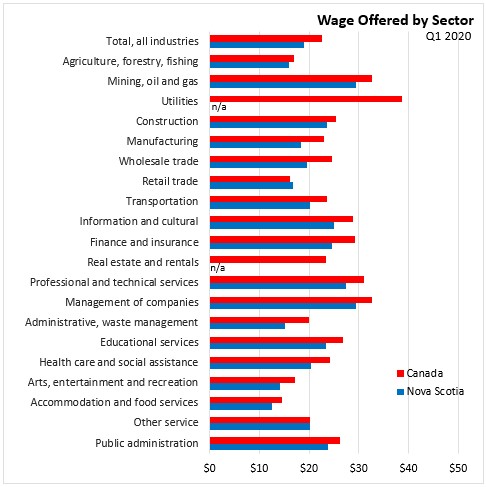
Across sectors with available data, Nova Scotia's job vacancy rates increased the most over the last year (Q1 2020 vs Q1 2019) in administrative/waste management, information and cultural services, and retail trade. Vacancy rates declined the most in professional/technical services, arts, entertainment and recreation services, and construction.

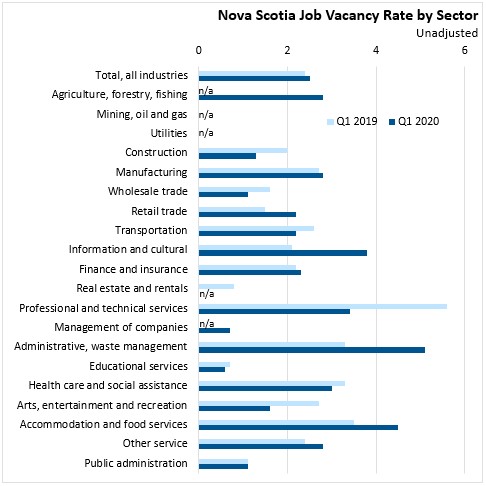
For sectors with available data, Nova Scotia's average hourly wages on vacant positions were highest in management of companies, mining, oil and gas, and professional/technical services. The fastest wage gains (Q1 2020 vs Q1 2019) were in construction, retail trade, and other services. Average wages offered on vacant positions fell the fastest in health care and social assistance, and mining, oil and gas.
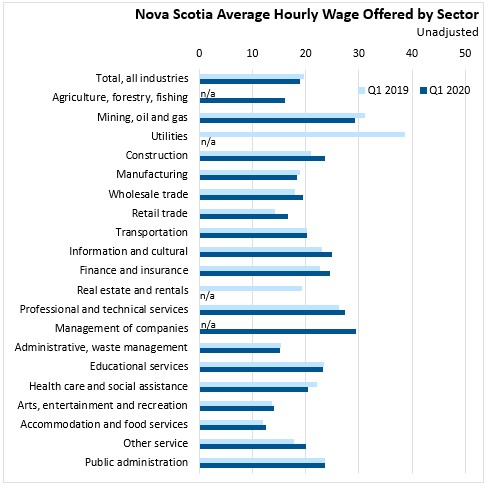
Of the 10,165 job vacancies reported in Nova Scotia during Q1 2020, the largest number (3,575) were in sales and service occupations. Sales/service vacancies increased 22.2% compared to the same period last year. Among occupations with data, vacancies were up for manufacturing and utilities, trades, transport, and equipment operators, sales and service, and education, law, community, and government.
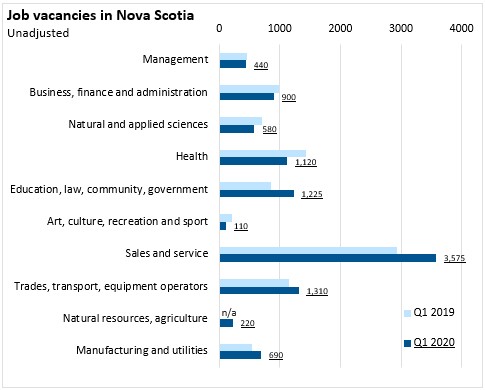
Average wages offered on vacant positions in Nova Scotia during Q1 2020 were highest for management, followed by natural/applied sciences and health occupations. Sales and service, natural resources and agriculture, and manufacturing/utilities occupations had the lowest wages offered on vacant positions in Q1 2020.
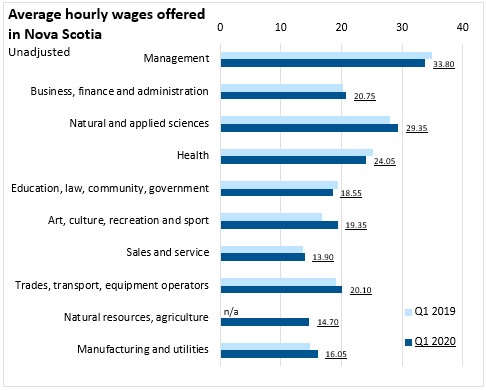
In Q1 2020, 58.6% of vacant positions in Nova Scotia required high school or lower levels of education, up from 53.5% of vacancies in Q1 2019. A lower proportion of vacant positions required an education level beyond high school in Q1 2020, accounting for 41.4% of vacancies compared to 46.5% in Q1 2019.
Wages offered for vacant positions requiring high school or lower education were less than wages offered on vacancies requiring more education. The fastest growth in wages offered (compared to Q1 2019) were for positions requiring a university certificate or diploma below a bachelor's level.
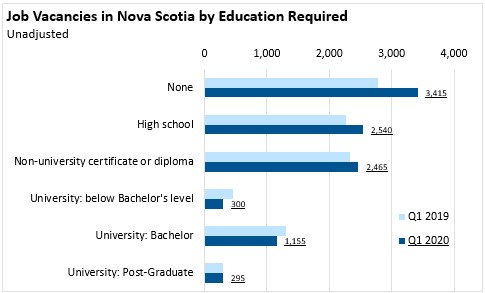
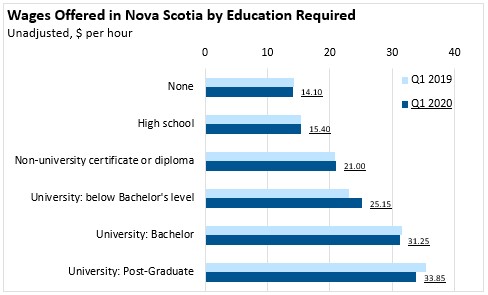
The number of vacant positions requiring less than three years of experience increased 27.4% compared to Q1 2019. The average wage offered on vacant positions decreased for experience levels less than 3 years and for jobs requiring 8+ years of experience (there are relatively few vacancies requiring more than 8 years of experience, which likely makes average wages offered on these vacancies highly variable).
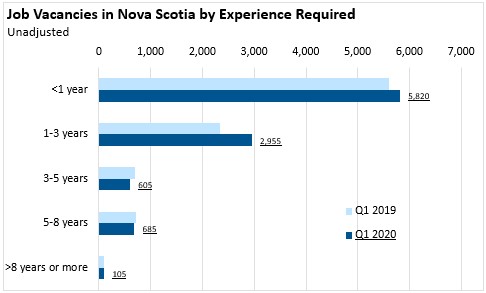

JVWS data are not seasonally adjusted. Therefore, quarter-to-quarter comparisons should be interpreted with caution as they may reflect seasonal movements.
Source: Statistics Canada.
<--- Return to Archive